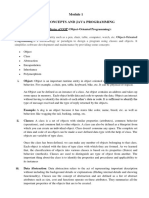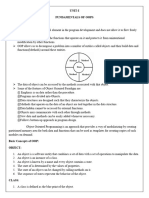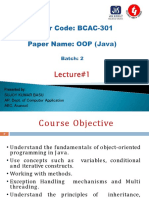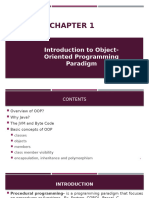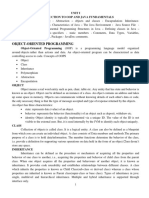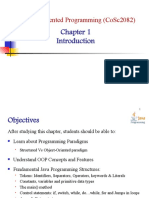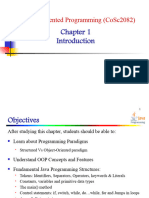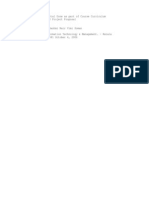0 ratings0% found this document useful (0 votes)
7 viewsProcedure Oriented Programming
The document compares Procedure Oriented Programming (POP) and Object-Oriented Programming (OOP), highlighting their fundamental differences, characteristics, and advantages. POP focuses on procedures and functions, while OOP emphasizes objects and their interactions, offering benefits like encapsulation, inheritance, and polymorphism. Additionally, it discusses Java's features, including its portability, security, and the role of bytecode in making it a compiled and interpreted language.
Uploaded by
Binayak SubudhiCopyright
© © All Rights Reserved
We take content rights seriously. If you suspect this is your content, claim it here.
Available Formats
Download as PDF, TXT or read online on Scribd
0 ratings0% found this document useful (0 votes)
7 viewsProcedure Oriented Programming
The document compares Procedure Oriented Programming (POP) and Object-Oriented Programming (OOP), highlighting their fundamental differences, characteristics, and advantages. POP focuses on procedures and functions, while OOP emphasizes objects and their interactions, offering benefits like encapsulation, inheritance, and polymorphism. Additionally, it discusses Java's features, including its portability, security, and the role of bytecode in making it a compiled and interpreted language.
Uploaded by
Binayak SubudhiCopyright
© © All Rights Reserved
We take content rights seriously. If you suspect this is your content, claim it here.
Available Formats
Download as PDF, TXT or read online on Scribd
You are on page 1/ 3
1.
Procedure Oriented Programming (POP) is a programming paradigm
that focuses on the procedures or functions that operate on data. It is based
on the concept of a modular approach to software design, where a large
program is broken down into smaller modules or functions. The
characteristics of POP are:
o It is based on the concept of a step-by-step procedure or function.
o It is a top-down approach to programming.
o It is based on the concept of a shared global data area.
o It is less secure than OOP.
o It is less flexible than OOP.
2. Object-Oriented Programming (OOP) is a programming paradigm that is
based on the concept of objects. It is a bottom-up approach to programming,
where a program is broken down into objects that interact with each other.
The characteristics of OOP are:
o It is based on the concept of objects.
o It is a bottom-up approach to programming.
o It is based on the concept of encapsulation, inheritance, and
polymorphism.
o It is more secure than POP.
o It is more flexible than POP.
3. The main difference between POP and OOP is that POP is based on the
concept of a step-by-step procedure or function, while OOP is based on the
concept of objects. In POP, the focus is on the procedures or functions that
operate on data, while in OOP, the focus is on the objects that contain both
data and functions.
4. The basic concepts of Object-Oriented Programming (OOP) paradigm are:
o Encapsulation: It is the process of hiding the implementation details
of an object from the outside world.
o Inheritance: It is the process of creating new classes from existing
classes.
o Polymorphism: It is the ability of an object to take on many forms.
o Abstraction: It is the process of hiding the complexity of an object
from the outside world.
5. A class is a blueprint for creating objects, while an object is an instance of a
class. A class defines a set of attributes and methods that are common to all
objects of that class. An object is an instance of a class that has its own set
of values for the attributes defined in the class.
6. Data encapsulation is the process of hiding the implementation details of
an object from the outside world. It is achieved by defining the attributes of
an object as private and providing public methods to access and modify
those attributes.
7. Data hiding is the process of hiding the implementation details of an object
from the outside world. It is achieved by defining the attributes of an object
as private and providing public methods to access and modify those
attributes.
8. Data abstraction is the process of hiding the complexity of an object from
the outside world. It is achieved by defining the attributes and methods of an
object as public or private and providing a simple interface to access and
modify those attributes and methods. Data abstraction is different from data
encapsulation in that it focuses on the interface to an object, while data
encapsulation focuses on the implementation details of an object.
9. Compile-time polymorphism is the process of selecting the appropriate
method or function at compile time based on the number and types of
arguments passed to it. It is also known as method overloading.
10. Run-time polymorphism is the process of selecting the appropriate method
or function at run time based on the type of object that is calling it. It is also
known as method overriding.
11. Static binding is the process of binding a method or function to its
associated class at compile time. It is also known as early binding. Dynamic
binding is the process of binding a method or function to its associated class
at run time. It is also known as late binding.
12. In an object-oriented program, data and methods are organized into classes.
A class defines a set of attributes and methods that are common to all
objects of that class. Objects are instances of classes that have their own set
of values for the attributes defined in the class.
13. Some of the benefits of Object-Oriented Programming (OOP) are:
o Modularity: OOP allows for the creation of modular code that can be
reused in other programs.
o Code reusability: OOP allows for the reuse of code through
inheritance.
o Encapsulation: OOP allows for the hiding of implementation details,
which makes code more secure and easier to maintain.
o Flexibility: OOP allows for the creation of flexible code that can be
easily modified and updated.
o Ease of testing: OOP allows for the creation of code that is easier to
test and debug.
14. Inheritance is a mechanism in Object-Oriented Programming (OOP) that
allows a new class to be based on an existing class. The new class inherits
the properties and methods of the existing class and can add its own
properties and methods. The advantages of inheritance are:
o Code reusability: Inheritance allows for the reuse of code from
existing classes.
o Flexibility: Inheritance makes the code flexible to change, as you will
adjust only in one place, and the rest of the code will work smoothly.
o Overriding: With the help of Inheritance, you can override the
methods of the base class.
o Data Hiding: The base class in Inheritance decides which data to be
kept private, such that the derived class will not be able to alter it.
15. The different features of Java language are:
o Simple: Java is easy to learn and understand.
o Object-Oriented: Java is an object-oriented programming language.
o Portable: Java is platform-independent and can run on any platform.
o Secure: Java is secure and provides a secure environment for
executing code.
o Robust: Java is robust and can handle errors and exceptions
gracefully.
o Multithreaded: Java supports multithreading, which allows multiple
threads to run concurrently.
o Dynamic: Java is dynamic and can adapt to changing environments.
16. Java is known as a compiled and interpreted language because it uses
both compilation and interpretation to execute code. Java source code is
compiled into bytecode by the Java compiler. This bytecode is then
interpreted by the Java Virtual Machine (JVM) at runtime. The JVM is
platform-dependent, but the bytecode is platform-independent, which makes
Java a compiled and interpreted language.
17. Java ensures portability because it uses bytecode, which is a platform-
independent code. Java source code is compiled into bytecode, which can
run on any platform that has a JVM installed. The JVM interprets the
bytecode and executes it on the platform. This makes Java programs
portable and allows them to run on any platform without modification.
18. Java is known as a platform-independent language because it uses bytecode,
which is a platform-independent code. Java source code is compiled into
bytecode, which can run on any platform that has a JVM installed. The JVM
interprets the bytecode and executes it on the platform. This makes Java
programs portable and allows them to run on any platform without
modification.
19. Java is more secure than other languages because of its built-in security
features. Java programs run inside a virtual machine sandbox, which
provides a secure environment for executing code. Java has no explicit
pointers, which eliminates the possibility of buffer overflow attacks. Java
also has a bytecode verifier, which checks the code fragments for illegal
code that can violate access rights to objects.
20. Bytecode is a special machine language native to the JVM. Java source code
is compiled into bytecode by the Java compiler. The JVM interprets and
executes this code at runtime. Bytecode is a platform-independent code,
which means that it can run on any platform that has a JVM installed.
You might also like
- Installation and Operation Manual: GS16 Gas Metering System100% (1)Installation and Operation Manual: GS16 Gas Metering System78 pages
- Module 1 - OOPS CONCEPTS AND JAVA PROGRAMMING - LectureNotesNo ratings yetModule 1 - OOPS CONCEPTS AND JAVA PROGRAMMING - LectureNotes42 pages
- Object Oriented Programming (Model Questions Sol)No ratings yetObject Oriented Programming (Model Questions Sol)31 pages
- Chapter 1 Introduction to Object Oriented Programming (1)No ratings yetChapter 1 Introduction to Object Oriented Programming (1)5 pages
- Unit-1 Basic Syntactical Concepts in Java: Introduction To Object-Oriented ParadigmNo ratings yetUnit-1 Basic Syntactical Concepts in Java: Introduction To Object-Oriented Paradigm45 pages
- Object Oriented Programming Structure:: Oops ConceptsNo ratings yetObject Oriented Programming Structure:: Oops Concepts4 pages
- Object Oriented Programming Chapter One Introduction Updated 2021No ratings yetObject Oriented Programming Chapter One Introduction Updated 202143 pages
- Object Oriented Paradigm:: Compiled By: Er. R. K. GuptaNo ratings yetObject Oriented Paradigm:: Compiled By: Er. R. K. Gupta88 pages
- 30 OOPs Interview Questions and AnswersNo ratings yet30 OOPs Interview Questions and Answers278 pages
- Dr. R. Manikandan Assistant Professor (Senior Grade) Vit Bhopal UniversityNo ratings yetDr. R. Manikandan Assistant Professor (Senior Grade) Vit Bhopal University92 pages
- The-Role-of-Technology-in-E-Learning-and-Education Redg no.2241041190No ratings yetThe-Role-of-Technology-in-E-Learning-and-Education Redg no.224104119015 pages
- Smart Agriculture Model in Detecting Oil Palm Plantation Diseases Using A Convolution Neural NetworkNo ratings yetSmart Agriculture Model in Detecting Oil Palm Plantation Diseases Using A Convolution Neural Network8 pages
- Document Submission Status: For Construction: KDL 120Mw Combined Cyle Power Plant ProjectNo ratings yetDocument Submission Status: For Construction: KDL 120Mw Combined Cyle Power Plant Project28 pages
- Deep Learning Foundations Taeho Jo download100% (1)Deep Learning Foundations Taeho Jo download45 pages
- A Multitier Deep Learning Model For Arrhythmia DetectionNo ratings yetA Multitier Deep Learning Model For Arrhythmia Detection9 pages
- Analysis of DC Link Operation Voltage of A Hybrid Railway Power Quality Conditioner and Its PQ Compensation Capability in High Speed Co-Phase Traction Power SupplyNo ratings yetAnalysis of DC Link Operation Voltage of A Hybrid Railway Power Quality Conditioner and Its PQ Compensation Capability in High Speed Co-Phase Traction Power Supply5 pages
- W2 Mobility Four Bar Slider Crank Mechanism 20140724No ratings yetW2 Mobility Four Bar Slider Crank Mechanism 2014072435 pages
- Database Management Systems Ramakrishnan 3rd Edition Raghu Ramakrishnan - The ebook with rich content is ready for you to download100% (1)Database Management Systems Ramakrishnan 3rd Edition Raghu Ramakrishnan - The ebook with rich content is ready for you to download57 pages
- 1 Frequently Asked Questions Diffusion-Weighted Imaging-00012754No ratings yet1 Frequently Asked Questions Diffusion-Weighted Imaging-000127544 pages
- DiagReport 2006 Astra-H Vehicle Vehicle DTC Information 201402191128No ratings yetDiagReport 2006 Astra-H Vehicle Vehicle DTC Information 2014021911286 pages
- Iot Based Driver Drowsiness Detection and Alert SystemNo ratings yetIot Based Driver Drowsiness Detection and Alert System5 pages


